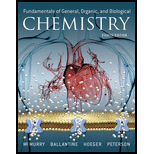
(a)
Interpretation:
The name of the given binary compound has to be determined.
Concept introduction:
Naming of molecular binary compounds (two element compounds),
The binary compounds of hydrogen with nonmetals are named as hydrogen followed by nonmetals name in ‘ide’ form (add ‘ide’ into stem of the name).
The binary compounds formed by combination of group 4A-7A elements are named as putting the first name as least electronegative elements and last name as most electronegative elements in ‘ide’ form. The more than one number of an element is named by adding prefix as “di-, tri-, tetra-, penta- and so on.
(b)
Interpretation:
The name of the given binary compound has to be determined.
Concept introduction:
Naming of molecular binary compounds (two element compounds),
The binary compounds of hydrogen with nonmetals are named as hydrogen followed by nonmetals name in ‘ide’ form (add ‘ide’ into stem of the name).
The binary compounds formed by combination of group 4A-7A elements are named as putting the first name as least electronegative elements and last name as most electronegative elements in ‘ide’ form. The more than one number of an element is named by adding prefix as “di-, tri-, tetra-, penta- and so on.
(c)
Interpretation:
The name of the given binary compound has to be determined.
Concept introduction:
Naming of molecular binary compounds (two element compounds),
The binary compounds of hydrogen with nonmetals are named as hydrogen followed by nonmetals name in ‘ide’ form (add ‘ide’ into stem of the name).
The binary compounds formed by combination of group 4A-7A elements are named as putting the first name as early group elements and last name as late group element in ‘ide’ form. The more than one number of an element is named by adding prefix as “di-, tr-, tetra-, penta- and so on.
(d)
Interpretation:
The name of the given binary compound has to be determined.
Concept introduction:
Naming of molecular binary compounds (two element compounds),
The binary compounds of hydrogen with nonmetals are named as hydrogen followed by nonmetals name in ‘ide’ form (add ‘ide’ into stem of the name).
The binary compounds formed by combination of group 4A-7A elements are named as putting the first name as early group elements and last name as late group element in ‘ide’ form. The more than one number of an element is named by adding prefix as “di-, tr-, tetra-, penta- and so on.
Want to see the full answer?
Check out a sample textbook solution
Chapter 4 Solutions
Pearson eText Fundamentals of General, Organic, and Biological Chemistry -- Instant Access (Pearson+)
- 9. Which one of the compounds below is a major final product of the reaction sequence shown at the right? A) para-bromonitrobenzene C) meta-bromoaniline B) meta-bromonitrobenzene D) para-bromoaniline 1. HNO3, H2SO4 2. Br₂, FeBr3 3. H₂/Ni (3 atm) E) ortho-bromoanilinearrow_forward10. This reaction sequence includes an intramolecular Friedel-Crafts reaction. Which of the compounds below is expected to be the major product? PhCH2CH2CH2COOH 4-phenylbutanoic acid SOCI₂ AICI 3 A B C D Earrow_forward5. Which one is the major organic product obtained from the following reaction sequence? A B C OH i 1. NaBH4 CI 2. H₂O, H+ AICI 3 D OH Earrow_forward
- 1. Which one is the major organic product obtained from the reaction of toluene and cyclopentanol in the presence of H3PO4, as shown here? CH3 CH3 CH3 CH3 CH3 H3PO4 A B с D E OHarrow_forwardAscorbic acid is a diprotic, with ionizations of: pKa1 = 4.10; pKa2 =11.80. You need to make 350 mL of an ascorbate buffer that is pH 5.05, andyou have 1.5 mM stock solutions of :ascorbic acidmonosodium ascorbatedipotassium ascorbateHow much 1.5 mM monosodium ascorbate do you use to make yoursolution? Answer in mL and report your value to three signicant gures.Please type only the number.arrow_forward1. What is the abbreviated form of the name for the molecule below. Punctuate it correctly ( image attached) 2. How much ATP is formed by the complete oxidation of lignocerate? Show stepsarrow_forward
- fill in the blank and circle the active site for each molecule. urgent!arrow_forwardfill in the table and circle the active sitearrow_forwardThe two half reactions for beginning and end of the electron transport chain are given below in standard form. Calculate & for the overall process. Using the Nernst equation (AG° = -n Fo, F= 96.485 kJ/volt mol), calculate AG°. Explain the need for a stepwise process in the electron transport chain. NAD* + H+ + 2 e- = NADH ½ 0г + 2H+ + 2е- = H20 = -0.32v E = +0.82Varrow_forward
- answer the questions and the example steps should be from carbohydrates glycolysis and citric acid cycle. Please put down reactions and structuresarrow_forwardidentify the general type of reaction catalyzed and an example step from glycolisis structure for each of the following enzymes/ co factor Kinase, isomerase, mutase, dehydrogenase, NAD+ , FADarrow_forwardfill in the blanks with the missing structures and give namesarrow_forward
- Essentials Health Info Management Principles/Prac...Health & NutritionISBN:9780357191651Author:BowiePublisher:Cengage





